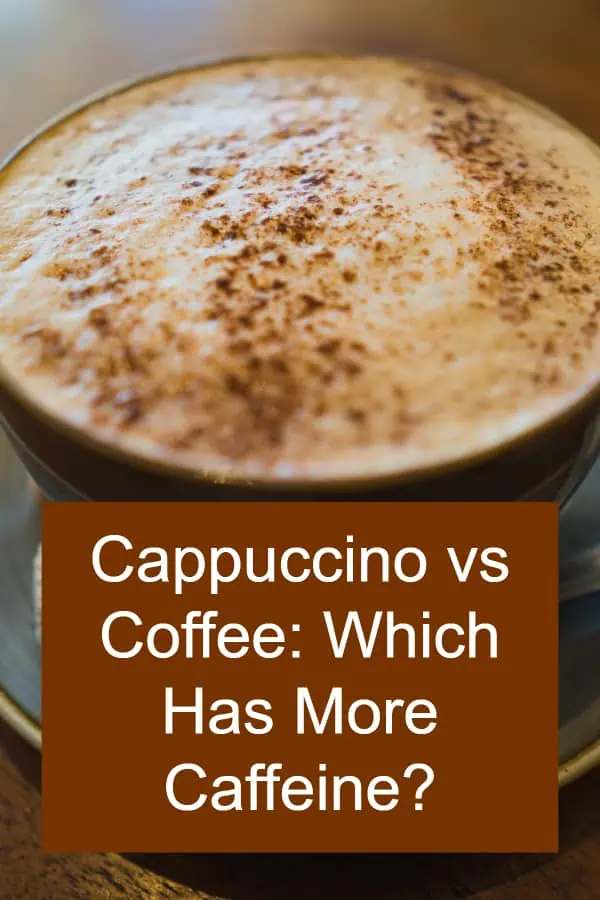Now we’re getting into a serious debate – Cappuccino vs Coffee: which of these timeless hot drinks contains more caffeine? We’ve all wondered about this common but longstanding question; does the intense crema of a cappuccino provide more of a caffeine punch than a classic black coffee, or is the opposite true? Well, today we’re here to finally answer each and every one of your burning questions. Put your feet up, grab a cup of your preferred coffee beverage, and let’s get into it!
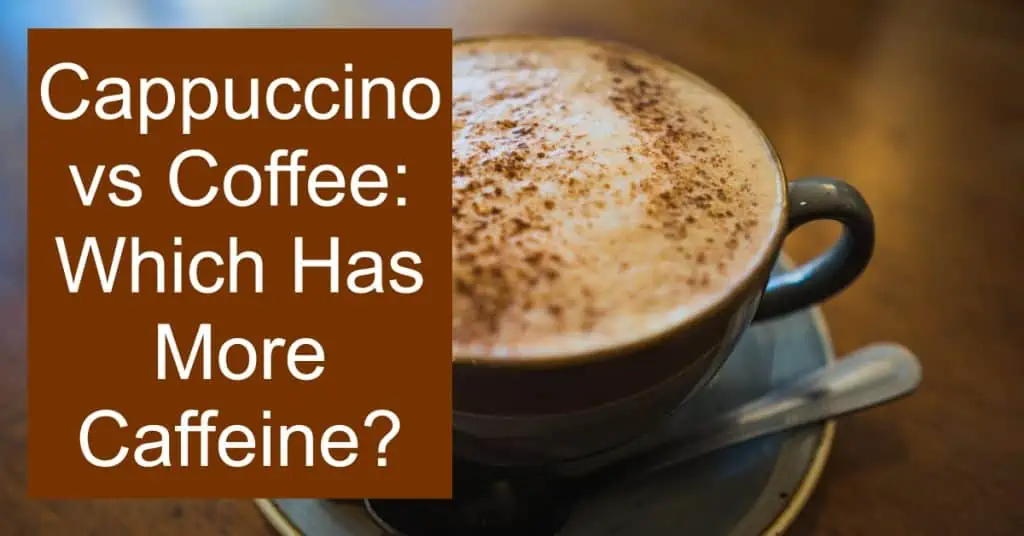
Quick Overview
A standard cappuccino contains approximately 75mg of caffeine while regular brewed coffee contains around 95mg per 8oz cup. However, it is important to note that specific levels of caffeine depend on the type of coffee beans and brewing method used.
Caffeine Content of Cappuccino vs Coffee
The caffeine content of cappuccino vs coffee varies depending on a few factors such as the specific type and preparation of the coffee, but both drinks generally contain a moderate to high levels of the stimulant.
When brewed in standard proportions at an average strength, coffee is typically more caffeinated than its cappuccino counterpart. An 8-ounce cup of standard filtered espresso contains anywhere from 77 to 150 milligrams of caffeine. It should be noted, however, that according to some sources, certain types of coffee can contain significantly more caffeine than others – as much as 200 milligrams per 8-ounce cup.
Cappuccino tends to have less caffeine than regular coffee due to its smaller volume. A standard 8-ounce cappuccino contains only about 120 milligrams of caffeine or 40 fewer milligrams than the same size portion of espresso. This lower amount may seem minor but is enough to produce a milder stimulatory effect with less jitteriness or insomnia.
Proponents of traditional cappuccino argue that the lower amounts of caffeine can still provide an alert feeling without the down side of potential unwanted effects associated with higher doses such as heart palpitations and anxiety attacks. The higher levels can also cause frequent visits to the bathroom due to diuretic effects The stimulating benefits appear to depend largely on how much one consumes and how quickly they absorb it into their system leading some people to conclude that it might be more beneficial for them in the long run if they opt out for the lighter dose that cappuccinos offer.
On the other hand, devotees of robusta brewed coffee may be drawn to its relative potency and are willing to endure any mild physical effects that accompany consuming it in order to take advantage of its strong flavor profile and longevity of action throughout their day-to-day activities.
Overall, when looking at an average serving size, caution should be taken when selecting which beverage one desires based upon their individual tolerance level for caffeine since there is a noticeable difference between these two types – cappuccino vs coffee.
The next section will explore varying degrees of caffeine in both drinks based upon different brewing methods and strength levels.
- A 12 oz cup of drip brewed coffee contains approximately 145 mg of caffeine, while an 8 oz cup of cappuccino contains approximately 73 mg of caffeine.
- According to The American Pregnancy Association, pregnant women are advised to avoid caffeine or only consume it in limited quantities. Generally speaking, this would mean 200mg or less per day.
- Caffeine is absorbed by the body much faster when consumed in liquid form compared to when it is pure powder. This means that beverages like coffee and cappuccinos will have a more immediate and stronger effect on the body than caffeine pills.
Key Takeaways
Coffee contains more caffeine than cappuccino when brewed in standard proportions and is typically 77 to 150 milligrams of caffeine per 8-ounce cup. Cappuccino has less caffeine in comparison, with an 8-ounce serving containing 120 milligrams. The effects of consuming coffee vs. cappuccino vary person to person and depend upon brewing methods and strength levels. It is important to consider tolerance levels when selecting a beverage as there is a noticeable difference between both types – cappuccino vs coffee.
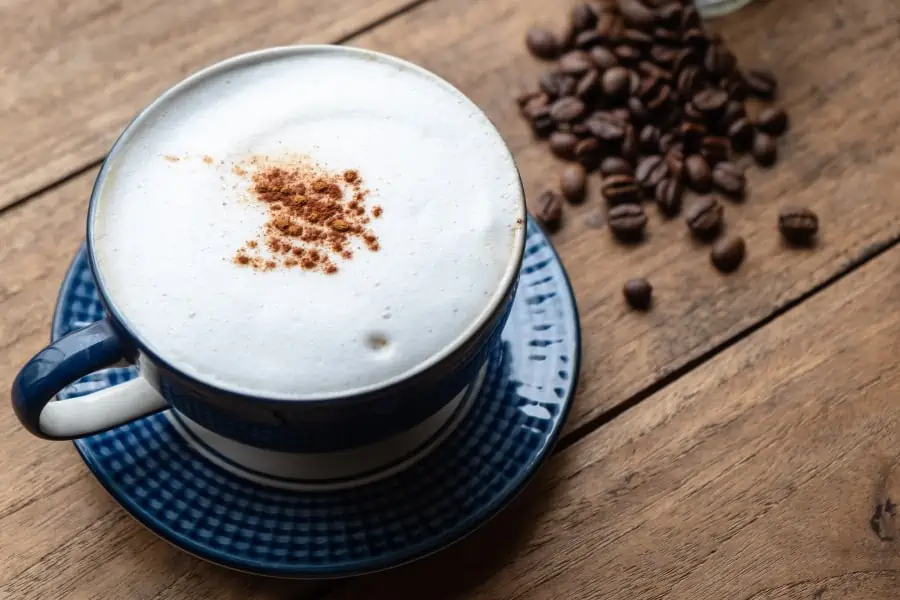
Varying Degrees of Caffeine
When discussing the differences in caffeine content between cappuccino and coffee, it’s important to note that there can be vast variations in both. There are a variety of brewing methods, the type of beans used, and other factors that can have an impact on levels of caffeine.
For example, a single shot of espresso generally has less caffeine than a single cup of brewed coffee. But drinks like cappuccino where multiple shots of espresso are used will normally result in a larger dose. Plus, Arabica beans contain about half the amount of caffeine as Robusta beans, so it’s always important to consider what is being used to make your beverage.
On the other hand, some coffees or mix-in ingredients such as creamers may have added fillers or additional chemicals that can reduce their overall level of caffeine even if the same brewing method or bean was used, resulting in a weaker brew.
Considering these varying degrees of caffeine content between cappuccino and coffee, it is important to understand how each drink is made and what types of beans are being used as well as any extra ingredients you may be adding. This will help you better anticipate how much energy you’ll receive from consuming each drink.
And while some may argue that one beverage is better than the other based on its relative power level, it’s ultimately up to individual preferences and lifestyle habits as we look further into comparing the two by examining their brewing process.
Next, let’s take a closer look at how cappuccino and coffee differ in terms of the process used for making each beverage and how that impacts their respective caffeine content.
Comparing the Brewing Process
When comparing the brewing process of cappuccino and coffee, the first distinction between the two is that cappuccino requires two consistent steps to make. The most common method to make cappuccino involves combining espresso with steamed milk and topping it off with a layer of foamed milk. On the contrary, coffee can be prepared by any number of brewing techniques such as drip, French press, pour over, etc.
Espresso is brewed by forcing hot water into ground coffee through a mesh filter or puck in a process that takes around 20-30 seconds. To get steamed and foamed milk, baristas use a steam wand or a machine. Depending on the tools and experience of the barista, they can create latte art designs in cups of cappuccino. The objective of frothing or steaming milk is to enrich its texture while introducing air bubbles which are responsible for this type of beverage’s thick foam topping.
In comparison, coffee doesn’t require special tools or skills to brew it; all you need is a method based on gravity that passes hot water through ground coffee beans in order to extract its flavor compounds. Brewing coffee does not require any specific ingredients other than water, but different grounds and types of beans can produce vastly different flavors. Additionally, other methods might require additional ingredients like capsules which contain already ground coffee beans for machines such as K-cup brewers.
After debating both sides of the brewing process when it comes to cappuccinos vs coffees, it’s clear that prior preparation and specialized tools are needed when creating a cup of cappuccino whereas other methods of making coffee require minimal effort and skill. In the following section, we’ll discuss differences between these two brewing techniques which will further illustrate why they each have their own benefits and drawbacks.

Differences in the Brewing Techniques
The brewing techniques for cappuccino and coffee are vastly different. Coffee is produced with a filter technique, passing hot water through ground beans to produce the final cup of coffee. Whereas cappuccino is prepared by combining espresso and hot milk in specific ratios. This leads to vast differences in the caffeine content from one drink to the next.
For example, when it comes to brewed coffee versus espresso, brewed coffee typically contains more caffeine than an espresso shot. A single shot of espresso typically contains 64 milligrams of caffeine, while brewed coffee usually ranges between 95-200 mg per serving depending on the strength of brew desired. On average, a 12 ounce cup of coffee contains around 95 milligrams of caffeine while a single ounce serving of espresso only has 64 mg.
Also, as espresso can be combined with various amounts of steamed milk and foam, there are different types of cappuccino drinks that may contain varying amounts of caffeine than their pure espresso counterparts due to their altered state when combined with milk and foam. For example, a standard cappuccino made with two ounces of espresso and six ounces steamed milk would contain approximately 94 milligrams of caffeine, obviously lower than its two-ounce espresso base containing 64 mg.
So overall, brewed coffee tends to have much more caffeine than an equivalent volume or shot size of cappuccino. This is largely due to the fact that coffee is typically brewed with more beans and for a longer duration than typical espressos used for cappuccinos. But as it stands, highly concentrated shots or servings of espresso will tend to have slightly higher amounts of caffeine than traditionally brewed coffee servings.
Based on these differences in the brewing process and preparation method, now let’s explore how milk can potentially impact the overall concentration levels of caffeine when making a cappuccino or latte… Next section: Impact Of Milk On Caffeine Content.
Impact of Milk on Caffeine Content
When discussing the difference between cappuccino and coffee with regard to their caffeine content, one must consider the impact that milk has on each beverage. Many people assume that cappuccino contains more caffeine than coffee to begin with because of its milky texture and taste. However, this is not necessarily the case.
The reason for this is that a standard cup of cappuccino consists of 1/3 espresso, 1/3 steamed milk, and 1/3 foamed milk, while a regular cup of coffee consists of simply brewed espresso or drip-coffee grounds – no milk whatsoever. Therefore, the amount of milk present in each beverage can make a significant difference in the overall caffeine content.
On one hand, cappuccinos are typically stronger in flavor due in part to the additional milk and foam. Added milk helps to mellow out the strong espresso flavors as well as its intensity. On average, adding milk to an espresso will reduce its caffeine content by about 25%, for a standard cup of cappuccino amounts to around 85 milligrams of caffeine compared to an average cup of black coffee (depending on brewing method). It’s important to note, however, that if you decide to go with a double-shot of espresso instead of one in your cappuccino, then it will contain even more caffeine than it would if made with just one shot.
Also worth considering is that certain types of milk contain more fats and proteins than others – this can be especially true for non-dairy options such as almond or coconut milk. These components tend to bind on to the molecules of caffeine which can cause the drink to become less caffeinated once consumed – essentially “locking” up some of the stimulating effects from the drink itself.
Overall, it’s clear that there is no definitive answer as far as which has more caffeine – it ultimately depends on what type of ingredients are used in both drinks as well as personal preference when it comes down to factors such as flavoring versus intensity. With all this in mind, let’s now move onto discussing different types of milk and how they might affect your daily dose of caffeine.
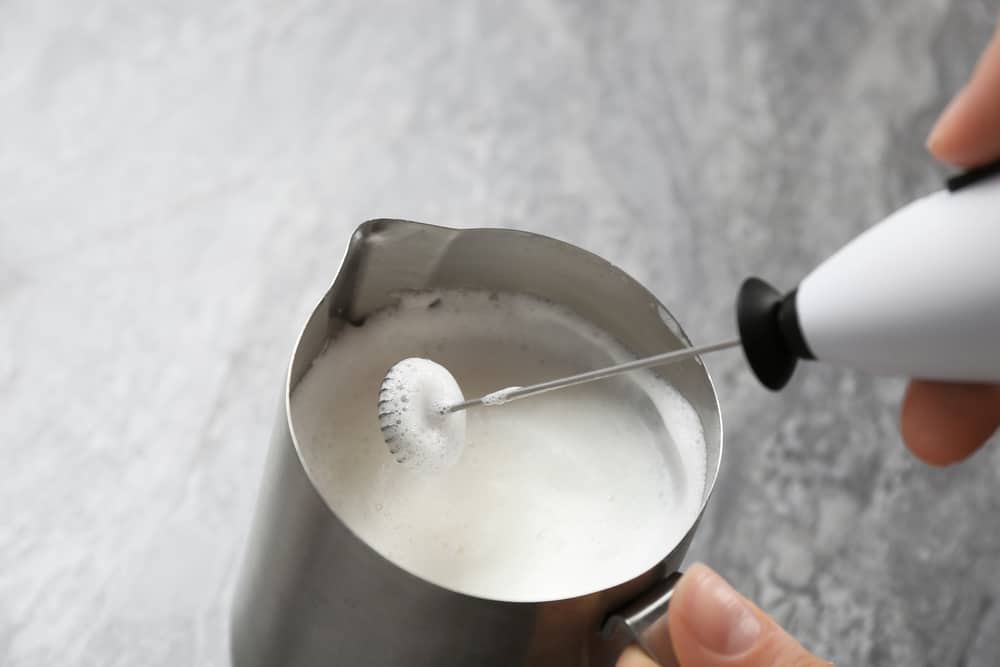
Different Types of Milk
When it comes to espresso-based drinks like cappuccinos and coffees, the type of milk found in each of them can make a huge difference. Certain types of milk provide more froth and creaminess, while other types of milk will change the flavor profile slightly. Also, different milks may have a different effect on how much caffeine you receive from each drink.
For instance, cow’s milk is the most common type used in both cappuccinos and coffees. It produces foam that is easy to work with and provides a creamy texture when mixed with espresso shots. Cow’s milk also has the best consistency for pulling espresso shots since the liquid does not separate when heated. Unfortunately, if you are trying to limit your caffeine intake then cow’s milk should be avoided because it contains higher levels of lactose which slows down caffeine absorption.
On the other hand, non-dairy milk such as soy or almond milk provides an entirely different flavor and texture profile than cow’s milk does. Soy milk often produces less foam when steamed compared to cow’s milk, but some people prefer its nutty flavor over the taste of cow’s milk. According to research, non-dairy milk may actually help increase the amount of caffeine in lattes and cappuccinos because they do not contain lactose — allowing more of the coffee’s caffeine to be extracted during preparation.
Ultimately, it is up to personal preference which type of milk is used in cappuccinos and coffees; however individuals should consider the effects that each one has on caffeine absorption before making their final decision.
Now that we understand the various types of milks available, let’s move onto discussing the flavour and strength comparison between cappuccino vs coffee in our next section.
Flavour and Strength Comparison
When it comes to flavor and strength comparison, there are some key differences between cappuccino and coffee that make each beverage unique. Coffee is usually brewed with hot water, providing a strong, deep flavor. Cappuccino combines espresso with hot or cold milk, making the drink sweeter, mellower, and lighter than traditional coffee. Additionally, cappuccino generally has less caffeine than a cup of coffee, as the shots of espresso used to make a cappuccino often measure smaller than traditional cups of drip coffee.
When it comes to strength, regular coffee is typically more robust than a cappuccino. When mixed with steamed or frothed milk for a cappuccino, this can reduce the strength of the drink. On the other hand, adding steam and frothed milk can increase the sweetness of the taste by adding creamy tones. Ultimately it is down to personal preference when it comes to flavor and strength preference between cappuccinos and coffees.
In the end whether you prefer a cup of traditional coffee or like to mix things up with a cappuccino or other espresso-based drinks depends on individual tastes. Next we will look into how steamed milk vs. frothed milk affects these beverages in terms of texture and taste.
Steamed Milk vs Frothed Milk
When making cappuccinos, steamed milk and frothed milk are two popular options. For those unfamiliar with frothed milk, this process adds air bubbles to the milk creating a creamy and foamy texture. It’s also known as “microfoam.” As for steamed milk, it is heated until it takes on a hot liquid form with few bubbles.
The potential downside of frothed milk is that any added air could reduce the amount of caffeine from being extracted from the coffee grounds when using espresso machines. Regarding steamed milk, more time will be required to properly heat it at a consistent temperature before adding it to espresso shots which could decrease the caffeine content in the cup. That said, an advantage of frothed milk is that it can help create thicker drinks due to the larger surface area created by its bubbles and foam. Similarly, steaming milk helps give cappuccinos their unique taste and texture as well as creating a thicker drink as compared to cow’s milk or oat milk alone.
For those looking for strong drinks with higher levels of caffeine, selecting steamed over frothed milk may be a better choice as fewer air bubbles are introduced into the beverage allowing for more of the extractable caffeine from the coffee grounds to be included in each cappuccino cup. Ultimately, both types offer different flavor profiles and textures for consumers interested in experimenting with cappuccinos and coffees depending on their individual tastes.
Next up: In this article we will discuss our conclusions about cappuccino and coffee caffeine content.
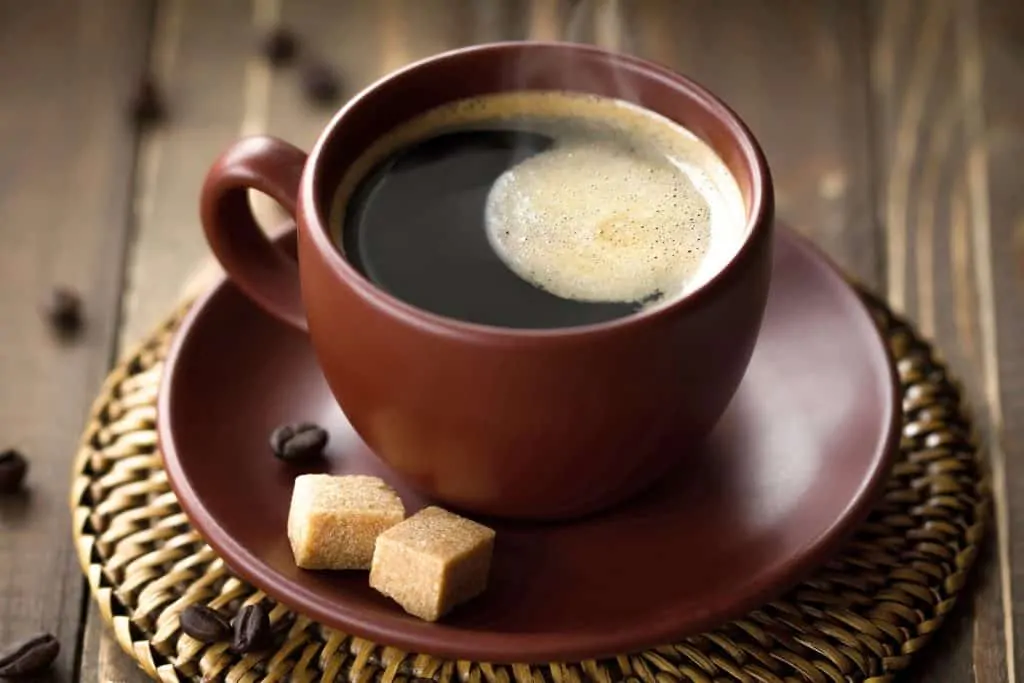
Conclusions About Cappuccino and Coffee Caffeine Content
The amount of caffeine in coffee and cappuccino ultimately depends on the type, size, strength, and method of making them. Generally speaking, if they are prepared using the same coffee-to-water ratio, coffee will usually have more caffeine than cappuccino. This is because coffee has less milk and fewer additional ingredients than cappuccino.
However, this difference might not be as significant as some people think. It’s important to remember that a standard serving of each beverage typically contains only around 95 to 100 milligrams of caffeine. Furthermore, the daily recommended maximum intake of caffeine is 400 milligrams, so even if one cup of either beverage had a bit more or less caffeine than the other, it would still not make a significant difference in terms of overall consumption for most people.
It should also be noted that espresso-based drinks like cappuccino tend to be stronger in flavor because of steamed milk and foam added to them. Therefore, you may end up drinking fewer servings than you would with black coffee. Ultimately, it’s best to consume either beverage in moderation to ensure your health and well-being.
Answers to Frequently Asked Questions
What is the difference in brewing methods between cappuccino and coffee?
The primary difference between cappuccino and coffee is how they are brewed. Coffee is typically brewed through a filter or a press, while cappuccino is made with espresso. When espresso is used to brew cappuccino, it involves passing hot water under pressure through finely-ground coffee beans. This method yields a much more concentrated and flavorful cup of coffee than the typical filter or press. Cappuccino also typically contains milk (either steamed or frothed) which makes it creamier and richer tasting than regular coffee.
What is the caffeine content of other popular coffee drinks?
Other popular coffee drinks, such as latte and mocha, contain more caffeine than cappuccino but less than a cup of straight coffee. A grande-sized latte (16 ounces) can contain between 150–360mg of caffeine, while a grande-sized mocha (16 ounces) contains a range between 90–200mg of caffeine. This is significantly less than the 95–165mg of caffeine per 8 ounces of brewed coffee.
Overall, brewed coffee contains the highest amount of caffeine when compared to other popular coffee drinks such as cappuccinos and lattes. As such, if you’re looking for a high-caffeine pick me up, then an 8 ounce cup of brew may be the best way to go.
What other nutritional differences are there between cappuccino and coffee?
When it comes to nutritional differences between cappuccino and coffee, the most glaring one is a calorie difference. Depending on the size and ingredients used, a cup of coffee can contain as little as 0 calories, while a cup of cappuccino can contain roughly 160 calories. This is because cappuccinos contain more added ingredients than coffee, such as milk and sugar, which increase the calorie count.
Another nutritional difference between cappuccino and coffee is the fat content. While brewed coffee generally contains no fat, cappuccinos can contain up to 8 grams of fat per cup, depending on the type of milk and cream used.
Caffeine content is also an important nutritional difference between these two beverages. While an 8 ounce cup of brewed coffee has 95-200 mg of caffeine depending on the blend, an 8 ounce cup of cappuccino typically has around 100 mg of caffeine due to its dilution with milk and cream.
Finally, there are also notable differences in calcium and vitamin B-12 content between cappuccino and coffee. Cappuccino usually has much higher contents of both nutrients due to it containing milk or cream while coffee generally does not.
Overall, when comparing cappuccino and coffee nutritionally, there are many differences that should be noted. From major ones like calorie count and caffeine level to minor ones like vitamin B-12 levels, knowing these differences could help you make an informed decision about choosing the best beverage for your needs.
